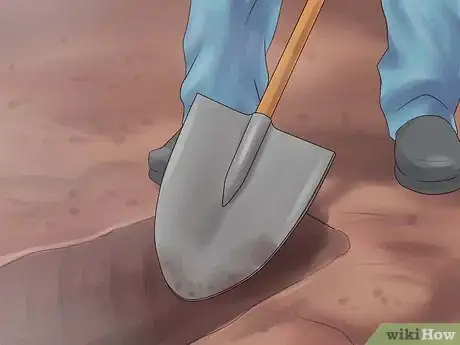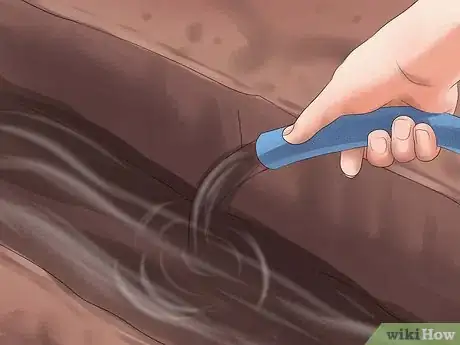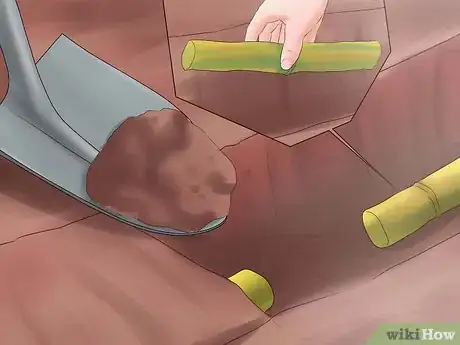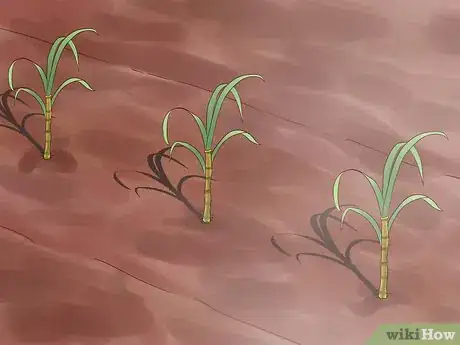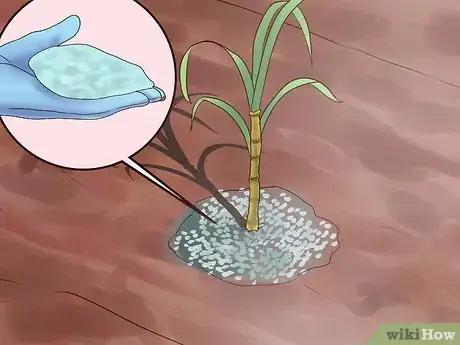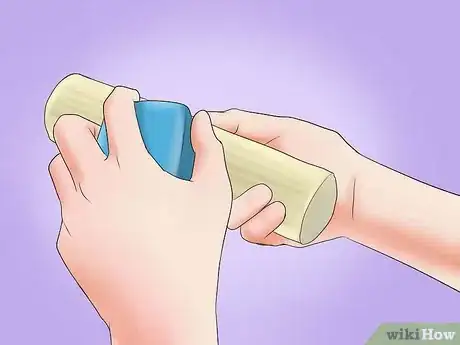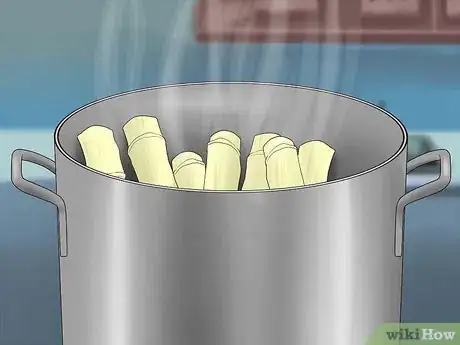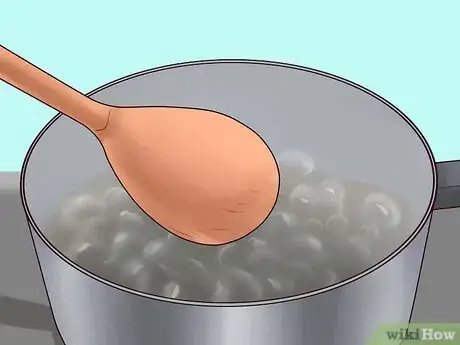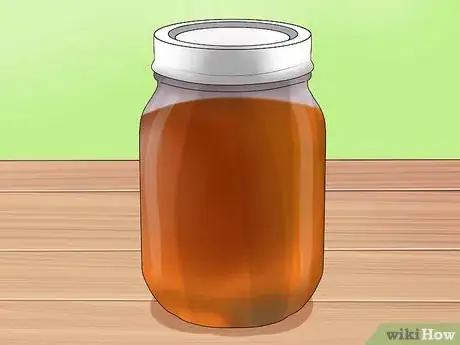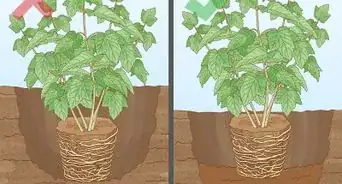This article was co-authored by Andrew Carberry, MPH. Andrew Carberry is a Food Systems Expert and the Senior Program Associate at the Wallace Centere at Winrock International in Little Rock, Arkansas. He has worked in food systems since 2008 and has experience working on farm-to-school projects, food safety programs, and working with local and state coalitions in Arkansas. He is a graduate of the College of William and Mary and holds a Masters degree in public health and nutrition from the University of Tennessee.
wikiHow marks an article as reader-approved once it receives enough positive feedback. This article received 12 testimonials and 94% of readers who voted found it helpful, earning it our reader-approved status.
This article has been viewed 556,088 times.
Sugar cane is in the same family as grass, and grows in the form of tall, narrow stalks, or canes. Sugar cane is planted in ruts on its side in the fall. It requires no maintenance over the winter, and in spring you'll be greeted with sugar cane sprouts that will grow as tall as bamboo. Sugar cane grows in the tropics, and it can be grown in the warmer parts of the United States. Currently, sugar cane is grown commercially in Florida, Louisiana, Hawaii, and Texas. If you live in one of these states, you can grow your own sugar cane. Harvested sugar cane can be made into delicious syrup.
Steps
Planting Sugar Cane
-
1Select healthy sugar cane plants. Sugar cane is easiest to find during the harvest season, in late summer and early fall. If you can't find sugar cane plants at your local garden center, it can often be found at roadside stands and farmer's markets. Asian groceries also often stock sugar cane plants.
- Look for long, thick stems, which are more likely to produce healthy new plants.
- The stems have joints, and a new plant will sprout from each one. Keeping this in mind, buy as many stems as you need to produce the size crop you want.
-
2Split the sugar cane stems into foot-long pieces. Leave three to four joints per piece, to make it more likely that each piece will produce a few sprouts. If the stems have any leaves or flowers, go ahead and remove them.Advertisement
-
3Dig furrows in a sunny planting spot. Sugar cane stems are planted horizontally on their sides, in four-inch deep furrows, or trenches. They need full sun, so choose an area that isn't shaded. Dig furrows long enough to fit each piece of cane you're planting, and space the furrows one foot apart.
- Use a spade or hoe, rather than a shovel, to make it easier to dig the furrows.
-
4Moisten the furrows. Use a hose to lightly moisten the furrows to prepare them for the sugar cane. Make sure the water has drained and there are no remaining puddles before you plant.
-
5Plant the sugar cane. Place the stems horizontally into the furrows. Cover them with soil. Do not plant stems upright, or they will not grow.
-
6Wait for the sugar cane to grow. In the spring, usually in April or May, shoots will start to grow from the nodes of the stems. You'll see them breaking through the soil to form individual sugar cane stalks, which will grow quite tall by summer's end.
Growing and Harvesting Sugar Cane
-
1Fertilize the sugar cane with nitrogen. Since sugar cane is a type of grass, it thrives on nitrogen-rich fertilizers. You can fertilize the sugar cane plants with standard grass fertilizer, or go for an organic option: chicken manure. Fertilizing just once, when the sprouts first emerge, will help the sugar cane grow strong and healthy so you'll have a good harvest in the fall.
-
2Weed the plant bed regularly. Sugarcane requires little maintenance except for weeding. Weeds could choke the new sprouts before they have the chance to grow. Constant weeding is necessary until the canes grow large enough to produce shade and choke harmful weeds on their own.
-
3Monitor for pests and disease. A number of pests and diseases can impact sugar cane. Pests such as borers and insects are more likely to impact a crop when they experience waterlogged conditions, while diseases can cause fungal growth and rot stocks. Check your sugar cane regularly for pests or rotting, and take preventative measures to discourage pests and diseases whenever possible.
- Selecting sugar cane varieties that are resistant to diseases and viruses known to affect crops in your area is one of the best pest management strategies.
- The application of controlled amounts of appropriate fungicides or pesticides may help prevent the propagation of a pest or disease within your crop.
- If you do spot a plant that appears to be infected with pests or a disease, remove it immediately.
-
4Wait until fall to harvest. Sugar cane plants should be left to grow for as long as possible before the first frost of the year. If they are left in the ground after the first frost, you will not be able to use your plants to make sugar syrup.
- If you live in a place with long, cold winters, play it safe and harvest your sugar cane by the end of September.
- If you live in a place with mild winters, you may be able to let your sugar cane grow until late October.
- If you live in the United States, you can check your area's frost dates by visiting http://www.almanac.com/gardening/frostdates/states.
-
5Use a machete to cut the canes close to the ground. The mature stalks will be tall and thick, similar to bamboo, so simple garden shears won't cut it. Use a machete or a saw to cut the sugar cane as close to the ground as possible, so you'll be able to make use of as much of the plant as possible.
-
6Don't hack into the ground. You don't want to damage the roots of the established sugar cane plants. If you leave the roots in the ground, your sugar cane will come up again next year.
-
7Strip the leaves from the cut sugar cane. Be sure to wear gloves since the leaves are quite sharp. Use them to cover up the planting bed. The leaves will act as an organic mulch that will protect the sugar cane roots over the winter. If you don't have enough leaves to cover the whole bed, use some extra straw to finish the job.[1]
Making Sugar Cane Syrup
-
1Scrub the stems. After a season outside, they'll have mildew and dirt on them. Use warm water and a scrub brush to scrub dirt and debris from the stems until they're completely clean.[2]
-
2Chop the stems into one-inch sections. The stems will be quite stiff, so a meat cleaver is a better tool for the job than a knife. Chop the stem into small sections, then chop those in half so you have a pile of small pieces of sugar cane.[3]
- If you had a commercial sugar cane press, chopping the stems wouldn't be necessary. On large farms, juice is extracted from sugar cane using huge, heavy presses. There is no equivalent machine suitable for home use, so the chop-and-boil-method is used instead.
-
3Boil the sugar cane pieces in a large stockpot filled with water. The sugar is extracted through a long process of boiling the pieces down for about two hours. The sugar water is ready when it has the same flavor as a piece of raw sugar cane. You'll have to taste-test it to determine when it's ready.[4]
- Another clue is to look at the sugar cane pieces. After a few hours, the color will turn to a light brown, which indicates the sugar has been extracted.
- Check the pot every half hour or so to make sure that the pieces are still covered with water; if not, add more.
-
4Pour the sugar water through a strainer into a smaller pot. Use the strainer to catch all the fibrous pieces of sugar cane. You don't need these anymore, so you can discard them.
-
5Cook down the sugar water to turn it into syrup. Boil the sugar water until it cooks down significantly and takes on the texture of thick syrup. This can take anywhere from one to two hours, so be sure to monitor the pot to make sure you don't overcook it. To test whether the syrup is ready, dip a cold spoon in the pot and check the texture.[5]
- If you like your syrup on the thin side, you can remove it from heat when it still easily slides from the back of the spoon.
- For thicker syrup, remove it from heat when it coats the back of the spoon instead of slipping right off.
-
6Pour the syrup into a glass canning jar. Place a lid on the jar and allow the syrup to cool completely before storing it in a cool, dry place.
Expert Q&A
Did you know you can get expert answers for this article?
Unlock expert answers by supporting wikiHow
-
QuestionHow do I treat sugar cane that is diseased?
 Andrew Carberry, MPHAndrew Carberry is a Food Systems Expert and the Senior Program Associate at the Wallace Centere at Winrock International in Little Rock, Arkansas. He has worked in food systems since 2008 and has experience working on farm-to-school projects, food safety programs, and working with local and state coalitions in Arkansas. He is a graduate of the College of William and Mary and holds a Masters degree in public health and nutrition from the University of Tennessee.
Andrew Carberry, MPHAndrew Carberry is a Food Systems Expert and the Senior Program Associate at the Wallace Centere at Winrock International in Little Rock, Arkansas. He has worked in food systems since 2008 and has experience working on farm-to-school projects, food safety programs, and working with local and state coalitions in Arkansas. He is a graduate of the College of William and Mary and holds a Masters degree in public health and nutrition from the University of Tennessee.
Food Systems Expert
-
QuestionDoes sugar cane need a lot of water?
 Andrew Carberry, MPHAndrew Carberry is a Food Systems Expert and the Senior Program Associate at the Wallace Centere at Winrock International in Little Rock, Arkansas. He has worked in food systems since 2008 and has experience working on farm-to-school projects, food safety programs, and working with local and state coalitions in Arkansas. He is a graduate of the College of William and Mary and holds a Masters degree in public health and nutrition from the University of Tennessee.
Andrew Carberry, MPHAndrew Carberry is a Food Systems Expert and the Senior Program Associate at the Wallace Centere at Winrock International in Little Rock, Arkansas. He has worked in food systems since 2008 and has experience working on farm-to-school projects, food safety programs, and working with local and state coalitions in Arkansas. He is a graduate of the College of William and Mary and holds a Masters degree in public health and nutrition from the University of Tennessee.
Food Systems Expert
-
QuestionHow long does it take sugarcane to grow?
 Community AnswerIt takes about a year to fully grow sugarcane. Some species can take about a year and a half.
Community AnswerIt takes about a year to fully grow sugarcane. Some species can take about a year and a half.
Warnings
- The leaves of sugar cane plants can scrape or injure your skin. Always wear gloves or other hand protection when removing leaves and flowers from the plant.⧼thumbs_response⧽
- Your syrup could burn if you let it boil for too long.⧼thumbs_response⧽
- Be careful when handing it during the boiling process so that you don't burn yourself.⧼thumbs_response⧽
- Keep a close watch on your syrup during the final boiling stages because it could boil over, causing a huge mess.⧼thumbs_response⧽
References
- ↑ http://www.motherearthnews.com/organic-gardening/grow-sugar-cane-zbcz1311.aspx#axzz3Lzpmx9V5
- ↑ http://www.thesurvivalgardener.com/how-to-make-cane-syrup-at-home-without-2/
- ↑ http://www.thesurvivalgardener.com/how-to-make-cane-syrup-at-home-without-2/
- ↑ https://www.thekitchn.com/pantry-staples-diy-cane-sugar-131934
- ↑ http://www.thedoityourselfmom.com/2013/05/diy-fresh-sugarcane-or-sugar-cane-syrup.html
About This Article
To plant sugar cane, select healthy sugar cane plants with long, thick stems and split the stems into foot-long pieces, leaving 3 to 4 joints per piece. Next, select a location that gets full sun and dig 4-inch deep furrows that are wide enough to plant the canes horizontally on their sides. Then, lightly moisten the soil, place the stems horizontally into the furrows, and cover them with soil. You should see the new plants breaking through the soil in the spring! For tips on harvesting your sugar cane, read on!


